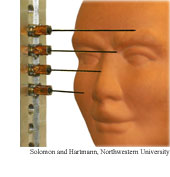|
NEWS
|
Robot
whiskers
 Robotic whiskers designed to mimic the sensitive
spatial perception of rat and seal whiskers record the
three-dimensional shapes of objects it brushes across.
The device could provide land and underwater robots with
an additional navigational and exploratory sensor. (Robotic
Whiskers Used to Sense Features, Nature, October
5, 2006)
Robotic whiskers designed to mimic the sensitive
spatial perception of rat and seal whiskers record the
three-dimensional shapes of objects it brushes across.
The device could provide land and underwater robots with
an additional navigational and exploratory sensor. (Robotic
Whiskers Used to Sense Features, Nature, October
5, 2006)
Teleporting light to matter
Scientists have teleported the quantum information
contained in a light beam onto a cloud of cesium atoms
in the first demonstration of quantum teleportation between
light and matter. Teleportation is a key component of
quantum networks and many proposed quantum computers.
Quantum computers have the potential to solve certain
problems like cracking secret codes that are beyond the
reach of ordinary computers. (Quantum
Teleportation between Light and Matter, Nature,
October 5, 2006)
Quantum light chip
A microfabricated array of silicon disks is the
platform for the quantum interaction between light and
single atoms. The device is a step toward mass-producible
chip-based quantum computers and quantum network equipment.
(Observation
of Strong Coupling between One Atom and a Monolithic Microresonator,
Nature, October 12, 2006)
Virus bits
Coating single tobacco mosaic viruses with platinum
nanoparticles turns them into memory elements similar
to the individual bits in flash memory chips. The metalized
viruses could be a route to inexpensive, high-capacity
nanoelectronic memory devices. (Digital
Memory Device Based on Tobacco Mosaic Virus Conjugated
with Nanoparticles, Nature Nanotechnology,
October 2006)
Dose and antidote in one
A DNA-based nanoparticle carries an anticoagulation
drug and its antidote, which is activated by exposure
to ultraviolet light. The nanoparticle medicine gives
physicians a quick off switch for anticoagulants, which
are used to treat ailments like blood clots and heart
attacks, in cases of bleeding or other side effects. (An
Anticoagulant with Light-Triggered Antidote Activity,
Angewandte Chemie International Edition, October
13, 2006)
Soapy nanotube sorter
Single-walled carbon nanotubes have great potential
for nanoelectronics, but they come in conducting and semiconducting
forms that are difficult to separate. Coating carbon nanotubes
with soap-like substances and spinning them in a centrifuge
causes the two types to separate. A variation of the technique
can separate nanotubes by diameter. (Sorting
Carbon Nanotubes by Electronic Structure Using Density
Differentiation, Nature Nanotechnology, October
2006) |
FEATURES
|
View
from the High Ground: ICL's John Pendry
Physics as machine tool, negative refractive
index, metamaterials, shattered wine glasses, higher capacity
DVDs, scientific backwaters, risk perception and practice,
practice, practice.
|
How
It Works: Quantum computing: qubits
Photons, electrons and atoms, oh my! These particles are
the raw materials for qubits, the basic building blocks
of quantum computers. |
|
 |
News RSS feed 
Blog RSS feed 
Bookshelf RSS feed

New: TRN's
Internet Services
TRN's Jobs Center
|
| |
|
| |
|
| |
"Physics
is to the rest of science what machine tools are
to engineering. A corollary is that science places
power in our hands which can be used for good or
ill. Technology has been abused in this way throughout
the ages from gunpowder to atomic bombs."
- John Pendry, Imperial College London |
|
| |
|
| |
Thanks
to Kevin from
GoldBamboo.com
for technical support |
|

